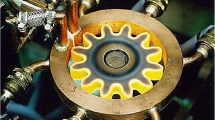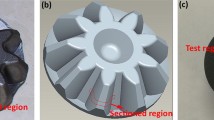Abstract
The design of a hardening process that can achieve the desired level of hardening quality is paramount for spur gear teeth, as a poorly executed process may result in a variety of defect schemes. The mobile induction hardening technique has emerged as a promising and cost-effective method for large spur gears. However, achieving the desired output quality remains challenging. This study aims to comprehensively evaluate the results of gear tooth hardening using the tooth-to-tooth mobile induction hardening process. The evaluation process focuses on the tooth flank, which is the area most prone to failure. The study investigates the effects and interactions of crucial process parameters, such as flank length, scanning speed, and air gap, on the hardening results. Numerical and experimental measurements are used to characterize the hardening results. The study’s results demonstrate high accuracy in the modeled numerical simulation, with prediction errors ranging from 3.02 to 4.05% across different experiment-numerical validation scenarios. The induction heating and spray cooling design employed in the study generates sufficient heating energy to achieve an average austenite distribution of 97.13% in the heat-affected zones and an average martensite phase of 82.21% during the quenching process. A tempering process is then carried out as a standard procedure to enhance the material’s ductility, resulting in a decrease in material hardness from a maximum of 64.77 HRC initially to a maximum of 61.98 HRC. Multivariable non-linear regression analysis confirms the significant influence of the studied process parameters on flank hardening quality, with the scanning speed parameter having the most substantial impact. The quantitative results indicate that reducing the scanning speed, air gap, and flank length leads to better hardening quality in terms of longer hardened flank, deeper hardening depth, and smaller edge effects. Insights provided in this study are very beneficial to build intuitions in obtaining desired hardening quality of tooth flank using mobile induction hardening.



























Similar content being viewed by others
Data availability
The data that support the findings of this research are available from the corresponding author on reasonable request.
References
Bauer E, Bohl A (2010) Flank breakage on gears for energy systems. Gear Technology. https://www.geartechnology.com/ext/resources/issues/1111x/bauer.pdf. Accessed 18 Dec 2023
Ristivojević M, Lazović T, Vencl A (2013) Studying the load carrying capacity of spur gear tooth flanks. Mech Mach Theory 59:125–137. https://doi.org/10.1016/j.mechmachtheory.2012.09.006
Hein M, Tobie T, Stahl K (2017) Parameter study on the calculated risk of tooth flank fracture of case hardened gears. J Adv Mech Design, Syst Manuf 11(6):JAMDSM0074. https://doi.org/10.1299/jamdsm.2017jamdsm0074
Liu H, Liu H, Bocher P, Zhu C, Sun Z (2018) Effects of case hardening properties on the contact fatigue of a wind turbine gear pair. Int J Mech Sci 141:520–527. https://doi.org/10.1016/j.ijmecsci.2018.04.010
Octrue M, Ghribi D, Sainsot P (2018) A contribution to study the tooth flank fracture (TFF) in cylindrical gears. Procedia engineering 213:215–226. https://doi.org/10.1016/j.proeng.2018.02.023
Haimbaugh RE (2015) Practical induction heat treating, 2nd edn. Materials Park, Ohio
Rakhit A (2000) Heat treatment of gears: a practical guide for engineers. Materials Park, Ohio
Rudnev V, Loveless D, Cook RL (2017) Handbook of induction heating. CRC Press
Rudnev V, Loveless D, Marshall B, Dyer N, Black M, Shepeljakovskii K (2000) Gear heat treating by induction. Gear Technology 17(2):57–63
Fu X, Wang B, Zhu X, Tang X, Ji H (2017) Numerical and experimental investigations on large-diameter gear rolling with local induction heating process. Int J Adv Manuf Technol 91:1–11. https://doi.org/10.1007/s00170-016-9713-y
Karban P, Donátová M (2010) Continual induction hardening of steel bodies. Math Comput Simul 80(8):1771–1782. https://doi.org/10.1016/j.matcom.2009.12.004
Wen H, Han Y (2017) Study on mobile induction heating process of internal gear rings for wind power generation. Appl Therm Eng 112:507–515. https://doi.org/10.1016/j.applthermaleng.2016.10.113
Barglik J, Smagór A, Smalcerz A, Desisa DG (2021) Induction heating of gear wheels in consecutive contour hardening process. Energies 14(13):3885. https://doi.org/10.3390/en14133885
Gao K, Qin X (2020) Effect of feed path on the spot continual induction hardening for different curved surfaces of AISI 1045 steel. Int Commun Heat Mass Transfer 115:104632. https://doi.org/10.1016/j.icheatmasstransfer.2020.104632
Gendron M, Hazel B, Boudreault E, Champliaud H, Pham X-T (2019) Coupled thermo-electromagnetic model of a new robotic high-frequency local induction heat treatment system for large steel components. Appl Therm Eng 150:372–385. https://doi.org/10.1016/j.applthermaleng.2018.12.156
Wen H, Zhang X, Ye H, Han Y (2021) Research on the mechanism of magnetic flux concentrator in the gap-to-gap induction heating of wind power gear. Int J Therm Sci 168:107055. https://doi.org/10.1016/j.ijthermalsci.2021.107055
Parvinzadeh M, SattarpanahKarganroudi S, Omidi N, Barka N, Khalifa M (2021) A novel investigation into edge effect reduction of 4340 steel spur gear during induction hardening process. Int J Adv Manuf Technol 113(1):605–619. https://doi.org/10.1007/s00170-021-06639-w
Khalifa M, Barka N, Brousseau J, Bocher P (2019) Reduction of edge effect using response surface methodology and artificial neural network modeling of a spur gear treated by induction with flux concentrators. Int J Adv Manuf Technol 104:103–117. https://doi.org/10.1007/s00170-019-03817-9
Khalifa M, Barka N, Brousseau J, Bocher P (2019) Sensitivity study of hardness profile of 4340 steel disc hardened by induction according to machine parameters and geometrical factors. Int J Adv Manuf Technol 101:209–221. https://doi.org/10.1007/s00170-018-2892-y
Cano-Pleite E, Fernández-Torrijos M, Santana D, Acosta-Iborra A (2022) Heat generation depth and temperature distribution in solar receiver tubes subjected to induction. Appl Therm Eng 204:117902. https://doi.org/10.1016/j.applthermaleng.2021.117902
Zhao Y-Q, Han Y, Xiao Y (2020) An asynchronous dual-frequency induction heating process for bevel gears. Appl Therm Eng 169:114981. https://doi.org/10.1016/j.applthermaleng.2020.114981
Wen H, Xiao Y, Han Y, Zhao Y, Wang S (2023) Research on scanning induction heating process of wind turbine gear: dynamic evolution of end temperature. Int J Precis Eng Manuf-Green Technol 10(2):509–520. https://doi.org/10.1007/s40684-022-00465-5
Saputro IE, Chen C-P, Jheng Y-S, Huang H-C, Fuh Y-K (2023) Mobile induction heat treatment of large-sized spur gear—the effect of scanning speed and air gap on the uniformity of hardened depth and mechanical properties. Steel Res Int 94(3):2200261. https://doi.org/10.1002/srin.202200261
Tong D, Gu J, Totten GE (2017) Numerical simulation of induction hardening of a cylindrical part based on multi-physics coupling. Modell Simul Mater Sci Eng 25(3):035009. https://doi.org/10.1088/1361-651X/aa5f7c
Mittemeijer EJ, Somers MA (2014) Thermochemical surface engineering of steels. Woodhead Publishing Cambridge
Mioković T, Schulze V, Vöhringer O, Löhe D (2006) Prediction of phase transformations during laser surface hardening of AISI 4140 including the effects of inhomogeneous austenite formation. Mater Sci Eng, A 435:547–555. https://doi.org/10.1016/j.msea.2006.07.037
Saunders N, Guo Z, Li X, Miodownik A, Schillé JP (2004) The calculation of TTT and CCT diagrams for general steels. JMatPro Software Literature. http://jmatpro.ru/artikles/The%20Calculation%20of%20TTT%20and%20CCT%20diagrams%20for%20General%20Steels.pdf. Accessed 18 Dec 2023
Trzaska J (2016) Calculation of critical temperatures by empirical formulae. Arch Metall Mater. https://doi.org/10.1515/amm-2016-0167
Koistinen DP, Marburger R (1959) A general equation prescribing the extent of the austenite-martensite transformation in pure iron-carbon alloys and plain carbon steels. Acta Metall 7(1):59–60
Mühl F, Damon J, Dietrich S, Schulze V (2020) Simulation of induction hardening: simulative sensitivity analysis with respect to material parameters and the surface layer state. Comput Mater Sci 184:109916. https://doi.org/10.1016/j.commatsci.2020.109916
Kaiser D et al (2020) Experimental investigation and finite-element modeling of the short-time induction quench-and-temper process of AISI 4140. J Mater Process Technol 279:116485. https://doi.org/10.1016/j.jmatprotec.2019.116485
Trzaska J (2016) Empirical formulas for the calculations of the hardness of steels cooled from the austenitizing temperature. Arch Metall Mater 61(3):951–956. https://doi.org/10.1515/amm-2016-0214
Mukherjee M, Dutta C, Haldar A (2012) Prediction of hardness of the tempered martensitic rim of TMT rebars. Mater Sci Eng, A 543:35–43. https://doi.org/10.1016/j.msea.2012.02.041
Prandtl L von (1924) Spannungsverteilung in plastischen Körpern. In: Proceedings 1st international congress on applied mechanics. Delft, pp 43–54
Reuss A (1930) Berücksichtigung der elastischen Formänderung in der Plastizitätstheorie. ZAMM-J Appl Math Mech/Zeitschrift für Angewandte Mathematik und Mechanik 10(3):266–274
Funding
This research was supported and funded by SHIEH YIH Machinery Industry Co., Ltd., Taiwan (R.O.C.) in commitment to providing reliable press machines for industrial application.
Author information
Authors and Affiliations
Contributions
Imang Eko Saputro: writing—original draft; numerical model; formal analysis; investigation; validating. Chih-Pin Chiang: funding acquisition, resources, project administration. Hung-Chieh Huang: data curation; drafter; conducting experiment; writing—review and editing. Yiin-Kuen Fuh: conceptualization; methodology; analysis; supervision; writing—review and editing.
Corresponding author
Ethics declarations
Ethics approval
For this type of study, formal consent is not required.
Consent to participate
The informed consent to participate was obtained from all authors.
Consent for publication
The informed consent to publish was obtained from all authors.
Competing interests
The authors declare no competing interests.
Additional information
Publisher's Note
Springer Nature remains neutral with regard to jurisdictional claims in published maps and institutional affiliations.
Rights and permissions
Springer Nature or its licensor (e.g. a society or other partner) holds exclusive rights to this article under a publishing agreement with the author(s) or other rightsholder(s); author self-archiving of the accepted manuscript version of this article is solely governed by the terms of such publishing agreement and applicable law.
About this article
Cite this article
Saputro, I.E., Chiang, CP., Huang, HC. et al. Origin of non-uniform tooth flank hardening distribution in SCM440 mobile induction heat–treated steel spur gears—a parametrical study with experimental–numerical coupled investigation. Int J Adv Manuf Technol 130, 2915–2938 (2024). https://doi.org/10.1007/s00170-023-12859-z
Received:
Accepted:
Published:
Issue Date:
DOI: https://doi.org/10.1007/s00170-023-12859-z




